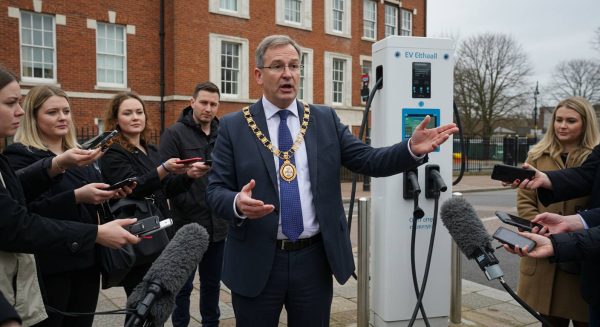Imagine your local high street transformed with convenient electric vehicle (EV) charging points, making the switch to electric cars as easy as finding a parking space. This isn’t just a dream—it’s a possibility that your elected mayor can help make reality, thanks to the Automated and Electric Vehicles Act 2018.
The Mayor’s Request Power
The Act gives elected mayors a unique ability to champion their communities’ charging needs. Think of it as a direct line to central government—mayors can formally request that large fuel retailers in their area install EV charging points. It’s similar to how local councils can require shops to maintain their shopfronts, but on a larger scale for modern transportation needs.

How Does It Work?
Before making a request, mayors must do their homework. The Act requires them to publish their proposals and consult with three key groups: local authorities in their area, the businesses that would need to install the chargers, and other relevant stakeholders. This consultation process ensures that everyone’s voice is heard, from local residents to business owners.
Local Consideration and Planning
Consider a mayor identifying that a particular neighbourhood has many terraced houses without driveways, making home charging impossible. After consulting with residents and local businesses, they might request that nearby fuel stations install charging points to serve this community. According to Department for Transport statistics, around 24% of households with a vehicle in England park on the street overnight, highlighting why such local knowledge is crucial for planning charging infrastructure.
The Secretary of State’s Role
When a mayor makes their request, the Secretary of State for Transport must consider it, provided three conditions are met: the proper consultation has taken place, feedback has been summarised and shared, and regulations defining “large fuel retailers” are in place. It’s like submitting a planning application—all the boxes need to be ticked before it can proceed.
Practical Impact for Communities
The real power of this legislation lies in its ability to address local needs. For example, if your area has a high proportion of electric taxis but insufficient rapid charging infrastructure, your mayor could use these powers to help create a more suitable charging network. The Act ensures that charging infrastructure grows in response to local requirements rather than following a one-size-fits-all approach.
What Happens Next?
If the Secretary of State decides not to implement the mayor’s request, they must explain why. This transparency ensures that decisions are well-reasoned and can inform future proposals. It’s worth noting that this power exists alongside other local authority abilities to improve charging infrastructure, such as installing on-street charging points through government grants.
Through this legislation, your mayor has a direct route to influence the development of EV charging infrastructure in your area. It’s just one example of how local democracy can shape the transition to cleaner transportation, making electric vehicle adoption more practical for everyone in the community.
